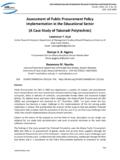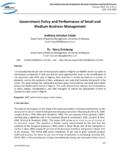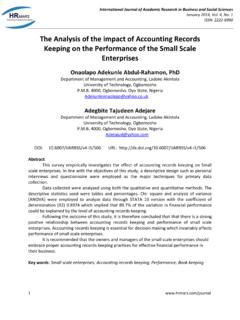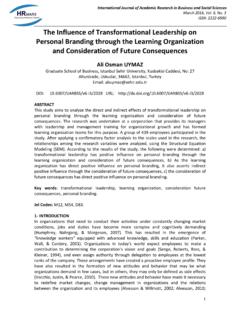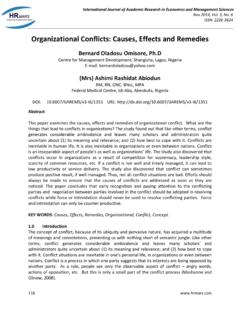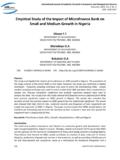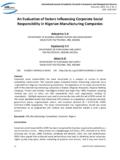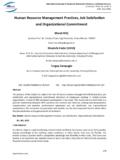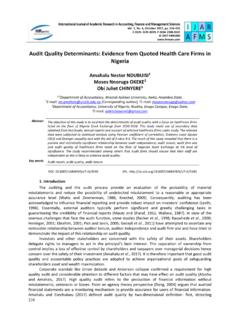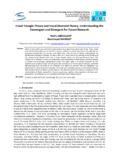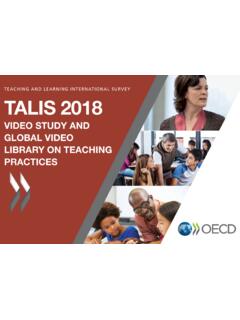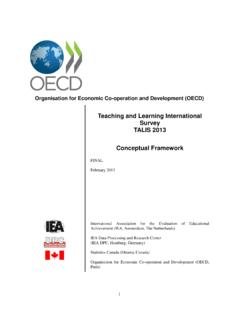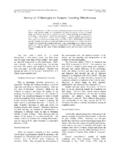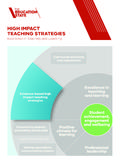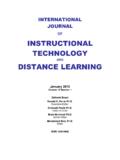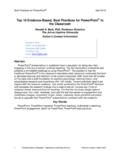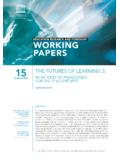Transcription of Determining Methods used in Teaching …
1 international Journal of Academic Research in Progressive Education and Development January 2014, Vol. 3, No. 1 ISSN: 2226-6348 220 Determining Methods used in Teaching Geography in Secondary Schools in Rongo District, Kenya Omoro Benjamin Department of Education, School of Social Studies, Rongo University College, Kenya Email: Nato, Luke Wakhungu Department of Education, School of Social Studies, Rongo University College, Kenya DOI: URL: Abstract This article dealt with Methods of Teaching Geography in Kenya but also the world over.
2 The importance of Geography in secondary school curriculum cannot be overemphasized. Improving the performance of Geography education is a great societal need in Kenya not only for industrialization of the country as contained in the vision 2030 but also for ensuring food security in the country through practices like land reclamation and irrigation farming The objective of this article was; to find out the Teaching Methods used by various Geography teachers in secondary schools in Rongo district. The research question was: Which are the Teaching Methods used by secondary school Geography teachers in Rongo district?
3 This study was guided by the Skinner s (1971) theory of Operant Conditioning which states that learning is based on consequences-reward. The respondent s behaviour (R) is under the control of stimulus (S). It is therefore a process through which organisms learn to repeat behaviour that yields positive outcomes. The study adopted the descriptive survey design and targeted students taking Geography in the district. Female students were 302 while male students were 704 in secondary schools in Rongo District, Kenya. The study sample consisted of 308 students and 11 Geography teachers drawn from 11 secondary schools in Rongo district.
4 The eleven schools is equivalent to thirty two per cent of secondary schools in Rongo district, which is considered statistically representative enough. Stratified random sampling was used to choose the schools to be included in the sample by using divisions as units of study. In order to identify the schools to be used from each division, simple random sampling was used . Purposive sampling was used to ensure that there is gender equity. The researcher used a questionnaire, observation and document content analysis as the main instruments for data collection. Data was collected using closed and open ended questionnaires.
5 The questionnaires were pre-tested by being administered to 30 respondents from two schools which were not included in the study. The scores obtained from the first and second tests were and respectively. The descriptive statistics including percentages mean and frequency tables were used to analyse the data. Data was also analysed using the Statistical Package for Social Sciences (SPSS) version computer programme. The results of the study indicated that the use of question and answer method by teachers is at while students preference for it is at 48%. The use of international Journal of Academic Research in Progressive Education and Development January 2014, Vol.
6 3, No. 1 ISSN: 2226-6348 221 field work by teachers is at while the students preference for it is at 75%. The study recommends that teachers to use the Teaching Methods which are preferred by students and are recommended by the syllabus. Keywords: Determining , Methods , Teaching , Geography, Secondary, Schools, Kenya Introduction Education is fundamental in the development of human beings and has been viewed principally as a fundamental human right (Abagi, 1999; Kyalo, Osano, Maundu and Kipkemboi, 2006). Worldwide, education is viewed as a prominent factor that helps in shaping of the future of individuals.
7 Such an important attachment to education can be established based on the investment that goes towards education in relation to other programmes in most countries (Ombok, 2007). Many countries of the world have allocated huge sums of money in their national budgets to enhance attainment of education to the citizens. In Kenya, about 30% of the national budget goes to education (Abagi and Olweya, 1999; Ngang a, 2010). The importance of Geography in secondary school curriculum cannot be overemphasized. It trains the learners to manage their environment for the good of the society as a whole (Bloomfield, 1970).
8 As one of the optional subjects in the secondary school curriculum, Geography is being taught in most Kenyan secondary schools (MoEST, 2005). The effectiveness of Teaching in the school can be measured by examining the Methods of Teaching applied by the teacher and the performance of students in the school examination (Eshiwani, 1987, 1988). It can be measured by the level of teachers subject matter competence which Mullens (2003) and Yambo (2012) regarded as a prime predictor of students learning. However, when a teacher teaches without adequate planning, he/she can do nothing better than recite notes to the learners while the learners become passive receivers.
9 The students performance in Geography at the end of the secondary school course has not been satisfactory for the last five years (KNEC 2004-2009). This raises a question among teachers and students as to why performance in Geography remains low year after year. Improving the performance of Geography education is a great societal need in Kenya not only for industrialization of the country as contained in the vision 2030 but also for ensuring food security in the country through practices like land reclamation and irrigation farming (NESC, 2007; Krathwohl, 2008).
10 The challenge thus has been how to make Geography more alive , more real and more manageable by secondary school students. It is, therefore important to examine the way this subject is taught in our secondary schools. Statement of the Problem In Kenya and especially in Rongo district, student s performance in Geography is poor and does not show any trend for improvement. For the last five years the subject has had a mean score of less than (mean grade of C) and below (Rongo District Education Officer, 2004-2009). international Journal of Academic Research in Progressive Education and Development January 2014, Vol.
